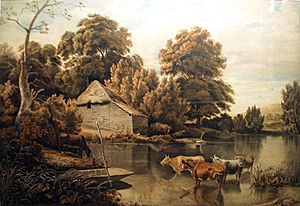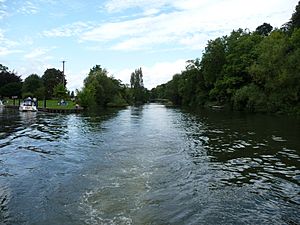Hedsor Water facts for kids

Hedsor Water is a special part of the River Thames in Berkshire, England. It flows near a town called Cookham and runs north of Sashes Island. Long ago, Hedsor Water was the main path for boats on the Thames. But in 1830, a new waterway called Cookham Lock was built. This new lock became the main route, and Hedsor Water was used less.
Today, only small boats can travel on Hedsor Water. They can go about 100 meters (about 330 feet) from its end. There are also a few places where boats can stop for a short time.
Contents
The History of Hedsor Water
Hedsor Water has an interesting past, especially with how it changed after Cookham Lock was built.
Cookham Lock and Its Impact
Cookham Lock opened in 1830. At first, there was no weir (a small dam) built across Hedsor Water. A few years later, in 1832, a person named Lord Boston lived nearby at Hedsor House. He said he should be paid because he lost the right to use the towpath along Hedsor Water. A towpath is a path next to a river where horses used to pull boats. He was given this payment.
Later, in 1837, people realized they needed a weir across Hedsor Water to help control the river's flow. When this weir was built, Lord Boston asked for more money. He said the weir was hurting his business at Hedsor Wharf.
Hedsor Wharf: A Busy Trading Spot
Hedsor Wharf was a very important place for trade. It was located on the upper part of Hedsor Water. Paper made at the nearby Cookham Paper Mill was sent from here. Also, the stone used to build a large house called Shardeloes was brought all the way from Oxford to Hedsor Wharf.
Because of the weir, Lord Boston said his wharf was losing business. This time, he only received a special type of lock called a "flash lock" built into the weir. This flash lock helped boats pass through the weir. However, when Cookham Lock was rebuilt in 1869, this flash lock was removed.
Public Access to Hedsor Water
In 2003, there was a legal case about Hedsor Water. A woman named Josie Rowland, who owned the Hedsor Wharf Estate, wanted to stop people from using Hedsor Water as a public waterway. She believed it was private.
However, the Environment Agency, which looks after England's environment, argued that people had a "Public Right of Navigation" on Hedsor Water. This right was protected by a law from 1885 called the Thames Preservation Act. A court agreed with the Environment Agency. The judge said that the public's right to use the water could only be changed by a new law. The judge also ordered that any signs saying the water was private should be taken down. This meant that Hedsor Water remains a public waterway for everyone to enjoy.



